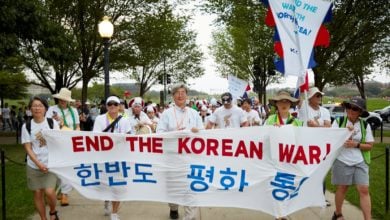 The Obama administration and its South Korean client government led
The Obama administration and its South Korean client government led
by the rabidly anti-communist President Lee Myung-bak are blaming the
Democratic People’s Republic of Korea (North Korea) for the latest
escalation of hostilities in the Korean Peninsula.
But in
reality the crisis there is the result of a policy of deliberate
provocation by the U.S. and South Korea over the past several months.
These provocations are targeting both the DPRK and the People’s Republic
of China, countries where the often-concealed but very real aim of U.S.
leaders — Democrats and Republicans alike – is “regime change.” They
could also lead to a new Korean war, one that could expand to wider
regional, and potentially nuclear, conflict.
While hypocritically calling for “calm” in words, Washington is
escalating the crisis by its actions. A U.S. naval group led by the nuclear
“super-carrier” USS George Washington is on its way to carry out joint
military maneuvers with South Korean warships in the Yellow Sea,
menacing both China and the DPRK. By moving this huge aircraft carrier
into the Yellow Sea the Pentagon and White House are sending a direct,
threatening message of escalation since China considers these waters to
be part of its sovereign territory.
On November 24, an unnamed “senior administration official”
confirmed that the U.S. is escalating pressure on China: “China clearly
does not like to see U.S aircraft carriers, for example, in the Yellow
Sea.” (NY Times, Nov. 25, 2010)
What’s needed to resolve the crisis
The DPRK wants direct talks with the United States, a formal
Peace Treaty ending the Korean War, and a normalization of relations
with the United States. This seemed like a realizable goal in the last
months of the Bill Clinton administration in 1999 and 2000. George W.
Bush scuttled these efforts shortly after taking office in 2001. The
Obama administration continued this policy with new sanctions and
endless war games simulating the invasion and bombing of North Korea.
The anti-war movement and all progressive people and organizations
should stand against any new war, and demand an end to the U.S.-South
Korean provocations.
In the latest incident, the North and South Korean armies exchanged
artillery fire on November 23. Two South Korean soldiers and two
civilians were reportcared killed and others wounded. Casualties on the
North Korean side have not been reported. As in all such previous
incidents, U.S. and South Korean leaders condemned the DPRK. But, as
even a close reading of the universally anti-North corporate media here
reveals, the first shells were fired by the South during military
exercises staged in a disputed sea area close to the west coast of North
Korea.
The North Korean government stated that it was “reacting to the
military provocation of the puppet group with a prompt powerful physical
strike,” and accused Seoul of starting the skirmish with its “reckless
military provocation as firing dozens of shells inside the territorial
waters of the” North.
The roots of the crisis
The
western sea border between the North and South is not recognized as
legitimate by the DPRK. It was unilaterally created by the United
States, using the mantle of the United Nations as a fig leaf and cover
for its actions, at the end of the 1950-53 Korean War. The U.S. and
allied forces fought the DPRK under the UN flag, slaughtering millions
of Korean people and leveling the northern half of the country by
massive bombing. That war further divided a historically unified
society into competing states. While an armistice was signed in July
1953, the U.S. has refused the demands of the DPRK to sign a Peace
Treaty formally bringing the war to an end.
U.S. “War Games” =
Preparation for Real War
In recent years there have been at least three clashes in the same
area as the November 23 incident. The DPRK had repeatedly warned South
Korea against carrying out the latest “war games” the area. In fact, the
term “war games” is a misnomer — these maneuvers should correctly be
called dress rehearsals for war. No one knows, moreover, whether any
particular military exercises is practice or the real thing, until it is
over and done with. This is especially true when the “war games” take
place in extremely close proximity to an enemy state.
The U.S. and South Korea annually stage such exercises close to both
China and the DPRK. The latest and largest joint drills were held this
past summer despite strong protests from both the PRC and DPRK. Those
“games,” labeled “Invincible Spirit,” included a simulated invasion of
the North.
China’s defense ministry especially objected to the presence of a
U.S. aircraft carrier close to its coast. In typical arrogant fashion, a
U.S. Defense Department spokesperson responded: “Where we exercise,
when we exercise, with whom and how, using what assets and so forth, are
determinations made by the U.S. Navy, the Department of Defense, by the
United States government.” (Agence France Presse, July 15, 2010)
Imagine for a moment the reaction in Washington if the Chinese navy
announced that it was planning to hold similar maneuvers right off-shore
of New York or Los Angeles.
The Number 1 Provocation – U.S. Military Presence
The biggest provocation of all is the massive presence of U.S.
military bases, troop, nuclear and conventional weapons in the region.
In 2010, 65 years after the end of World War II, there are scores of
U.S. Army, Air Force, Navy and Marine bases in Korea, Okinawa, and all
across Japan. The U.S. has provided high tech weaponry of all kinds to
Taiwan. Trident submarines, each of which can launch hundreds of nuclear
warheads, and nuclear-armed aircraft carriers prowl the eastern Pacific
round-the-clock.
This vast deployment of military power halfway around the world, far
exceeds that of any other country. It and the tens of billions of
dollars it burns up every year is justified to the people here as being
for “defensive purposes.” But that is just another Big Lie.
The real purpose of this monstrous military machine is to secure and
further the interests of the U.S. corporate power and strategic
domination in Asia and around the world. It is the enemy of the people
of Korea, China, Japan and the people of the United States.





